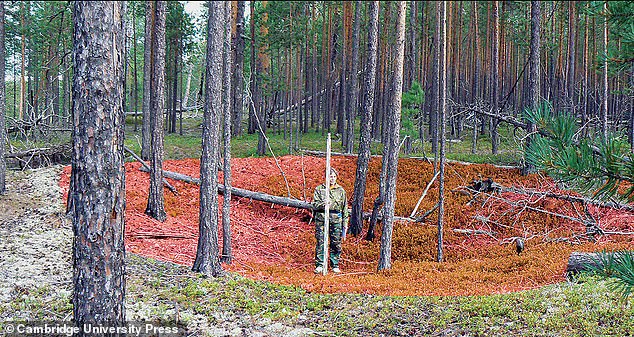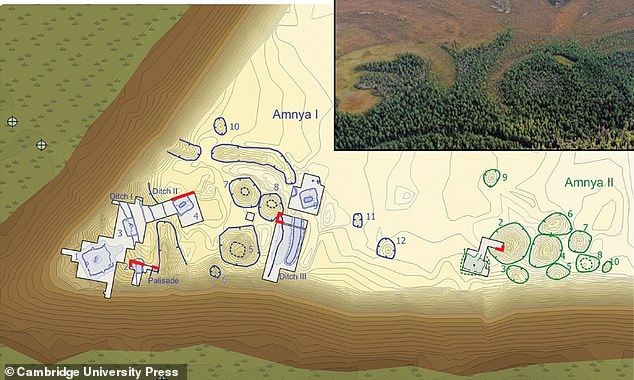World’s oldest fortress discovered in Siberia: Defensive complex built 8,000 years ago could reshape understanding of early human societies
Archaeologists have made a ground-breaking discovery in a remote region of Siberia, unearthing a nearly 8,000-year-old fortress built by hunter-gatherers.
Omnia Fort I and II are believed to be the oldest fortified settlement in the world and could prompt historians to reevaluate how complex societies developed.
Umniah Castle is located in a sandy area on the banks of the Umniah River, indicating that hunters chose the site to control the abundant fishing grounds.
Archaeologists found evidence that the site had been burned to the ground several times from the stratigraphy, or collection of sediment, soil and debris – and discovered arrowheads in the outer ditch, indicating violent conflict in the area.
The settlements of Omnia I and Omnia II were discovered on the coast of the Omnia River in Siberia, Russia

Archaeologists have found structural depressions that indicate it was the site of a long-term habitation
The team discovered wooden barriers indicating a fortified interior area while excavating the site from 1987 to 2000.
“These things that we're thinking about now, like property ownership and social inequality, people have been thinking about since we became human,” said Colin Greer of Washington State University. Science.org.
There are remains of 10 pits inside the wall, making up Amnia I.
Another 10 huts were found outside the fortified structure, indicating a pyramidal structure of a fortified inner area and an unprotected outer section identified as Omnia 2.
Building features such as raised central hearths indicated that the structures were long-term dwellings, contradicting the belief that permanent settlements and defensive structures only appeared in agricultural societies.
In their study, the authors at the Free University of Berlin state that the Omnia fort was built “several centuries before similar enclosures first appeared in Europe,” adding that although ancient hunter-gatherer groups constructed defenses around the world, “the beginning The very early onset of this phenomenon in Inner Western Siberia is unparalleled.
Researchers and archaeologists previously worked on the assumption that competition and conflict did not exist in hunter-gatherer societies.
However, using radiocarbon dating on the collected samples, archaeologists can confirm the “prehistoric age of the site” and identify it as “the oldest known fort in the world.”
Radiocarbon dating is a technique that looks at the decay of carbon-14 isotopes in samples, which can accurately determine the age of materials dating back 60,000 years.
Through detailed archaeological investigations at Umniah, we collected samples for radiocarbon dating, confirming the prehistoric age of the site and making it the oldest known fort in the world. Our new paleobotanical and stratigraphic examinations reveal that the people of western Siberia lived an advanced lifestyle dependent on the abundant resources of the taiga environment. press release He said.
He added: “This discovery reshapes our understanding of early human societies, and challenges the idea that only with the advent of agriculture did people begin to build permanent settlements of monumental architecture and develop complex social structures.”

Two sites have been discovered revealing a settlement surrounded by fortifications and a separate, unprotected habitation site.
Archaeologists also discovered approximately 45 pottery vessels at the Omnia site with pointed and flat shapes.
The study said that the two types of pottery represent two typological traditions, including “engraved decoration” and the second “comb seal decoration.”
Both types of pottery were found together, revealing the expansion of the use of ceramics.
Preserved bone fragments from elk, reindeer and beavers have been identified. The study said that there is evidence of re-settlement in the excavations of the first house of Omnia in the Mesolithic period in the eighth and early sixth centuries BC.
Excavators discovered a possible fourth case of re-settlement in some of the pits of the Omnia House 2, which is believed to have occurred during the Neolithic phase in the fourth century BC.
“The Omnia settlement complex represents the beginning of a unique and long-standing phenomenon of hunter-gatherer defensive sites in northern Eurasia, an almost uninterrupted tradition that continued for approximately eight thousand years until the Early Pleistocene.”
These discoveries change the traditional view that permanent settlements containing fortifications could only arise from agricultural farmers.
For many people, this is still not part of their hunter-gatherer nature. “There is still an element in archaeology that believes that complexity evolves over time,” Rick Schulting, an archaeologist at the University of Oxford, who was not part of the research, told Science.org.
“This is a nice study that shows that you can have alternative paths to complexity.”
(Tags for translation) Daily Mail
